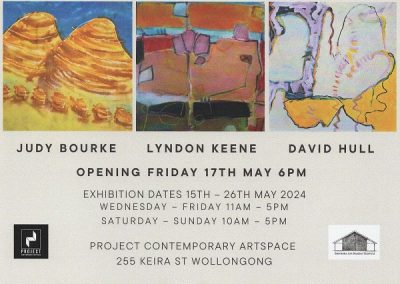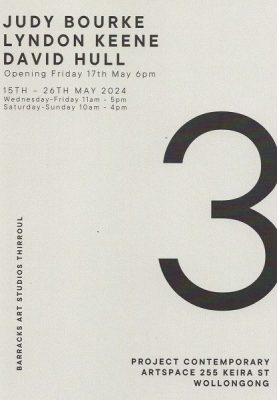3- Project Contemporary Artspace Exhibition 15-26 May 2024


Three prize-winning abstract artists collectively bring nearly 150 years of international experience to an exhibition opening at the Project Contemporary Artspace this month. While each artist has developed their own distinct, expressive style, they share approaches to their work that portray a sense of place and the histories and memories buried in it. All three – Judy Bourke, David Hull and Lyndon Keene – also share a work base at the Barracks Art Studios Thirroul.
Judy says ‘I am inspired by women’s achievements, family interactions, climate change, relationships, community events, found materials, colour, collections of objects and the patterns of seascapes and landscapes. I try to find the most appropriate media to express my ideas.’
David Hull studied art in the United Kingdom and Canada where as a young artist he was awarded the Canadian Federation of Artists prize of Young Contemporary Artist of the year. He has exhibited widely in Australia and overseas, as well as teaching drawing and painting for 28 years and helping to establish the School of Contemporary Arts at the University of Western Sydney.
“The sounds of a place and the interactions of humankind with place have been central to my work,” says David. “My approach is free improvisation, allowing processes to determine their own outcome that gives an authenticity to the work.”
Lyndon Keene also studied art in England but has lived mostly in Aotearoa New Zealand, where he exhibited widely over many years, including regularly at the New Zealand Art Shows and the New Zealand Academy of Fine Arts in Wellington. Since moving to Australia in 2015 he has begun to make his mark in exhibitions in Sydney, Melbourne and – leading up to this show – Brisbane.
“I’m in awe of the nature and my landscape-based abstracts aim to capture something of its poetry,” says Lyndon. “My approach is more about discovering than about making – reimagining the forms, colours and textures of remembered landscapes to find intuitively a hybrid kind of order that resonates.”
